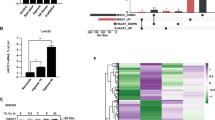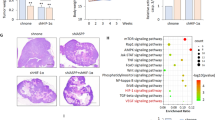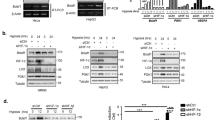Abstract
Loss of the coxsackie and adenovirus receptor (CAR) has been found in various human cancers. Underlying mechanisms, however, are still poorly understood. Therefore, the objective of this study was to investigate the function of hypoxia, a ubiquitous phenomenon in carcinomas, in CAR regulation. In our approach, hypoxia and treatment with cobalt-(II)-chloride (CoCl2) induced a downregulation of CAR protein and mRNA expression, as well as a suppression of CAR gene promoter activity in AGS (gastric), SW480 (colon) and PC3 (prostate) cancer cells. In line with these findings we noted a decreased adenoviral uptake under hypoxic conditions. Aiming to further elucidate the molecular basis of this observation, a full-length hypoxia-inducible factor-1α (HIF-1α) cDNA was ectopically overexpressed in the AGS cell line diminishing CAR expression and CAR gene promoter activity. In line with these findings, exposure of HIF-1α-deficient AGS cells to hypoxia did not alter CAR mRNA expression level. On the basis of these data, it may be suggested that loss of CAR in human cancer cell lines under hypoxic conditions occurs in an HIF-1α-dependent manner.
This is a preview of subscription content, access via your institution
Access options
Subscribe to this journal
Receive 12 print issues and online access
$259.00 per year
only $21.58 per issue
Buy this article
- Purchase on Springer Link
- Instant access to full article PDF
Prices may be subject to local taxes which are calculated during checkout



Similar content being viewed by others
Abbreviations
- CAR:
-
coxsackie and adenovirus receptor
- TJ:
-
tight junctions
- HIF-1α:
-
hypoxia-inducible factor-1α
- FCS:
-
fetal calf serum
- GFP:
-
green fluorescent protein
References
Bergelson JM, Cunningham JA, Droguett G, Kurt-Jones EA, Krithivas A, Hong JS et al. Isolation of a common receptor for coxsackie B viruses and adenoviruses 2 and 5. Science 1997; 275: 1320–1323.
Excoffon KJ, Hruska-Hageman A, Klotz M, Traver GL, Zabner J . A role for the PDZ-binding domain of the coxsackie B virus and adenovirus receptor (CAR) in cell adhesion and growth. J Cell Sci 2004; 117: 4401–4409.
Coyne CB, Voelker T, Pichla SL, Bergelson JM . The coxsackievirus and adenovirus receptor interacts with the multi-PDZ domain protein-1 (MUPP-1) within the tight junction. J Biol Chem 2004; 279: 48079–48084.
Cohen CJ, Shieh JT, Pickles RJ, Okegawa T, Hsieh JT, Bergelson JM . The coxsackievirus and adenovirus receptor is a transmembrane component of the tight junction. Proc Natl Acad Sci USA 2001; 98: 15191–15196.
Raschperger E, Thyberg J, Pettersson S, Philipson L, Fuxe J, Pettersson RF . The coxsackie- and adenovirus receptor (CAR) is an in vivo marker for epithelial tight junctions, with a potential role in regulating permeability and tissue homeostasis. Exp Cell Res 2006; 312: 1566–1580.
Mirza M, Raschperger E, Philipson L, Pettersson RF, Sollerbrant K . The cell surface protein coxsackie- and adenovirus receptor (CAR) directly associates with the Ligand-of-Numb Protein-X2 (LNX2). Exp Cell Res 2005; 309: 110–120.
Sollerbrant K, Raschperger E, Mirza M, Engstrom U, Philipson L, Ljungdahl PO et al. The coxsackievirus and adenovirus receptor (CAR) forms a complex with the PDZ domain-containing protein ligand-of-numb protein-X (LNX). J Biol Chem 2003; 278: 7439–7444.
Bruning A, Runnebaum IB . CAR is a cell-cell adhesion protein in human cancer cells and is expressionally modulated by dexamethasone, TNFalpha, and TGFbeta. Gene Ther 2003; 10: 198–205.
Bruning A, Runnebaum IB . The coxsackie adenovirus receptor inhibits cancer cell migration. Exp Cell Res 2004; 298: 624–631.
Huang KC, Altinoz M, Wosik K, Larochelle N, Koty Z, Zhu L et al. Impact of the coxsackie and adenovirus receptor (CAR) on glioma cell growth and invasion: requirement for the C-terminal domain. Int J Cancer 2005; 13: 738–745.
Okegawa T, Li Y, Pong RC, Bergelson JM, Zhou J, Hsieh JT . The dual impact of coxsackie and adenovirus receptor expression on human prostate cancer gene therapy. Cancer Res 2000; 60: 5031–5036.
Okegawa T, Pong RC, Li Y, Bergelson JM, Sagalowsky AI, Hsieh JT . The mechanism of the growth-inhibitory effect of coxsackie and adenovirus receptor (CAR) on human bladder cancer: a functional analysis of car protein structure. Cancer Res 2001; 61: 6592–6600.
Wang B, Chen G, Li F, Zhou J, Lu Y, Ma D . Inhibitory effect of coxsackie adenovirus receptor on invasion and metastasis phenotype of ovarian cancer cell line SKOV3. J Huazhong Univ Sci Technolog Med Sci 2005; 25: 85–87 93.
Buscarini M, Quek ML, Gilliam-Hegarich S, Kasahara N, Bochner B . Adenoviral receptor expression of normal bladder and transitional cell carcinoma of the bladder. Urol Int 2007; 78: 160–166.
Heideman DA, Snijders PJ, Craanen ME, Bloemena E, Meijer CJ, Meuwissen SG et al. Selective gene delivery toward gastric and esophageal adenocarcinoma cells via EpCAM-targeted adenoviral vectors. Cancer Gene Ther 2001; 8: 342–351.
Korn WM, Macal M, Christian C, Lacher MD, McMillan A, Rauen KA et al. Expression of the coxsackievirus- and adenovirus receptor in gastrointestinal cancer correlates with tumor differentiation. Cancer Gene Ther 2006; 13: 792–797.
Matsumoto K, Shariat SF, Ayala GE, Rauen KA, Lerner SP . Loss of coxsackie and adenovirus receptor expression is associated with features of aggressive bladder cancer. Urology 2005; 66: 441–446.
Rauen KA, Sudilovsky D, Le JL, Chew KL, Hann B, Weinberg V et al. Expression of the coxsackie adenovirus receptor in normal prostate and in primary and metastatic prostate carcinoma: potential relevance to gene therapy. Cancer Res 2002; 62: 3812–3818.
Sachs MD, Rauen KA, Ramamurthy M, Dodson JL, De Marzo AM, Putzi MJ et al. Integrin alpha(v) and coxsackie adenovirus receptor expression in clinical bladder cancer. Urology 2002; 60: 531–536.
Reid T, Galanis E, Abbruzzese J, Sze D, Wein LM, Andrews J et al. Hepatic arterial infusion of a replication-selective oncolytic adenovirus (dl1520): phase II viral, immunologic, and clinical endpoints. Cancer Res 2002; 62: 6070–6079.
Anders M, Christian C, McMahon M, McCormick F, Korn WM . Inhibition of the Raf/MEK/ERK pathway up-regulates expression of the coxsackievirus and adenovirus receptor in cancer cells. Cancer Res 2003; 63: 2088–2095.
Lacher MD, Tiirikainen MI, Saunier EF, Christian C, Anders M, Oft M et al. Transforming growth factor-beta receptor inhibition enhances adenoviral infectability of carcinoma cells via up-regulation of coxsackie and adenovirus receptor in conjunction with reversal of epithelial-mesenchymal transition. Cancer Res 2006; 66: 1648–1657.
Pong RC, Lai YJ, Chen H, Okegawa T, Frenkel E, Sagalowsky A et al. Epigenetic regulation of coxsackie and adenovirus receptor (CAR) gene promoter in urogenital cancer cells. Cancer Res 2003; 63: 8680–8686.
Vaupel P . The role of hypoxia-induced factors in tumor progression. Oncologist 2004; 9: 10–17.
Kurrey NK, K A, Bapat SA . Snail and Slug are major determinants of ovarian cancer invasiveness at the transcription level. Gynecol Oncol 2005; 97: 155–165.
Rohwer N, Welzel M, Daskalow K, Pfander D, Wiedenmann B, Detjen K et al. Hypoxia-inducible factor 1alpha mediates anoikis resistance via suppression of alpha5 integrin. Cancer Res 2008; 68: 10113–10120.
Anders M, Hansen R, Ding RX, Rauen KA, Bissell MJ, Korn WM . Disruption of 3D tissue integrity facilitates adenovirus infection by deregulating the coxsackievirus and adenovirus receptor. Proc Natl Acad Sci USA 2003; 100: 1943–1948.
Shen BH, Hermiston TW . Effect of hypoxia on Ad5 infection, transgene expression and replication. Gene Ther 2005; 12: 902–910.
Wenger RH, Stiehl DP, Camenisch G . Integration of oxygen signaling at the consensus HRE. Sci STKE 2005 re12 2005.
Kasuya H, Takeda S, Shimoyama S, Shikano T, Nomura N, Kanazumi N et al. Oncolytic virus therapy—foreword. Curr Cancer Drug Targets 2007; 7: 123–125.
Reid T, Galanis E, Abbruzzese J, Sze D, Wein LM, Andrews J et al. Hepatic arterial infusion of a replication-selective oncolytic adenovirus (dl1520): phase II viral, immunologic, and clinical endpoints. Cancer Res 2002; 62: 6070–6079.
Pipiya T, Sauthoff H, Huang YQ, Chang B, Cheng J, Heitner S et al. Hypoxia reduces adenoviral replication in cancer cells by downregulation of viral protein expression. Gene Ther 2005; 12: 911–917.
Yang ZR, Wang HF, Zhao J, Peng YY, Wang J, Guinn BA et al. Recent developments in the use of adenoviruses and immunotoxins in cancer gene therapy. Cancer Gene Ther 2007; 14: 599–615.
Acknowledgements
We thank Dr J Bergelson for providing the Chinese hamster ovary cells stably expressing human CAR (CHO-CAR), and Dr RC Pong and Dr JT Hsieh for providing the CAR gene promoter construct. Furthermore, we thank Dr Thorsten Cramer for helpful comments. This work was supported by a grant of the Deutsche Forschungsgemeinschaft to MA.
Author information
Authors and Affiliations
Corresponding author
Rights and permissions
About this article
Cite this article
Küster, K., Koschel, A., Rohwer, N. et al. Downregulation of the coxsackie and adenovirus receptor in cancer cells by hypoxia depends on HIF-1α. Cancer Gene Ther 17, 141–146 (2010). https://doi.org/10.1038/cgt.2009.49
Received:
Revised:
Accepted:
Published:
Issue Date:
DOI: https://doi.org/10.1038/cgt.2009.49
Keywords
This article is cited by
-
The Contribution of Ig-Superfamily and MARVEL D Tight Junction Proteins to Cancer Pathobiology
Current Pathobiology Reports (2016)
-
A simple detection system for adenovirus receptor expression using a telomerase-specific replication-competent adenovirus
Gene Therapy (2013)
-
Presence of the Coxsackievirus and Adenovirus Receptor (CAR) in human neoplasms: a multitumour array analysis
British Journal of Cancer (2013)
-
RETRACTED: Insulin-like Growth Factor-binding Protein-7 (IGFBP7); A Promising Gene Therapeutic for Hepatocellular Carcinoma (HCC)
Molecular Therapy (2013)
-
ZEB1 limits adenoviral infectability by transcriptionally repressing the Coxsackie virus and Adenovirus Receptor
Molecular Cancer (2011)



